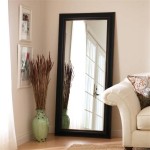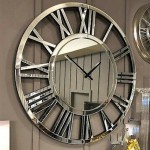How to Replace a Bathroom Wall Mirror
Replacing a bathroom wall mirror is a common home improvement project that increases the aesthetic appeal and functionality of a bathroom. This task, while seemingly straightforward, requires careful planning, preparation, and execution to ensure a safe and satisfactory outcome. This article provides a comprehensive guide to replacing a bathroom wall mirror, outlining the necessary steps, tools, and safety precautions.
Before embarking on the replacement process, it's crucial to understand the existing mirror's mounting method. Mirrors are typically attached to the wall using one of several methods: adhesive, clips, screws, or a combination thereof. Identifying the attachment method informs the removal process and ensures that the wall is not damaged unnecessarily.
Furthermore, it's vital to consider the size, shape, and style of the replacement mirror. Measure the available space accurately to ensure the new mirror fits appropriately. Consider the bathroom's existing décor and choose a mirror style that complements the overall aesthetic. Reflect on your personal design preferences and long-term goals for the bathroom’s appearance.
Preparing for the Mirror Replacement
Prior to commencing the physical replacement process, adequate preparation is essential. This involves gathering the necessary tools and materials, protecting the surrounding areas, and taking safety precautions. A well-prepared workspace minimizes the risk of accidents and ensures a smoother, more efficient replacement.
The following tools and materials are generally required for a bathroom wall mirror replacement:
- Safety glasses
- Work gloves
- Painter's tape
- Putty knife or scraper
- Pry bar (optional)
- Utility knife
- Hammer (optional)
- Screwdriver (appropriate for the existing screws, if any)
- Stud finder
- Level
- Measuring tape
- Drill (with appropriate drill bits)
- New mirror
- Mirror adhesive (if applicable)
- Mounting hardware (screws, clips, etc., as needed)
- Cleaning supplies (glass cleaner, rags)
- Trash bags
Cover the floor and surrounding fixtures with drop cloths or old sheets to protect them from debris and potential damage. Use painter's tape to protect the edges of the wall around the mirror, preventing paint chipping during the removal process. Proper protection of the surrounding area minimizes cleanup and reduces the risk of accidental damage.
Safety is paramount throughout the mirror replacement process. Always wear safety glasses to protect the eyes from glass shards or other debris. Wear work gloves to protect the hands from cuts and abrasions. If the mirror is large or heavy, enlist the help of another person to prevent accidents during removal and installation.
Removing the Existing Mirror
The mirror removal process varies depending on the attachment method. Proceed with caution, applying appropriate techniques for each specific scenario. The goal is to remove the mirror cleanly without damaging the wall behind it. Damage to the wall may lead to additional repairs and extend the duration of the project.
If the mirror is attached with clips or screws, locate and remove them first. Use a screwdriver to loosen any screws securing the mirror to the wall. Carefully detach the clips, making note of their positions for reinstallation later. Once the clips and screws are removed, the mirror should be easier to detach. If the mirror feels stuck, it is likely adhered with adhesive.
For mirrors attached with adhesive, use a putty knife or scraper to gently separate the mirror from the wall. Start at a corner and carefully work the putty knife behind the mirror, applying gentle pressure. Avoid using excessive force, as this could crack the mirror or damage the wall. A utility knife can be used to score the adhesive along the edges of the mirror to help loosen the bond. Work slowly and patiently, gradually separating the mirror from the wall.
If the adhesive is particularly stubborn, a pry bar may be necessary. Place a piece of wood between the pry bar and the wall to protect the surface. Use the pry bar to gently pry the mirror away from the wall, working slowly and carefully. Be aware that using a pry bar increases the risk of damaging the wall, so exercise caution. Another option is to use a heat gun or hair dryer to warm the adhesive, making it softer and easier to remove. Apply heat slowly and evenly, avoiding excessive heat that could damage the mirror or wall.
Once removed, carefully place the old mirror in a safe area for disposal. Broken glass can be extremely dangerous. Wrap the mirror in heavy cardboard or blankets before disposing of it to prevent injury. Check with local waste disposal services for specific guidelines on disposing of large pieces of glass.
After the mirror is removed, inspect the wall for any damage. Repair any holes or imperfections with spackle or drywall compound. Allow the repair material to dry completely before proceeding with the installation of the new mirror. Thoroughly clean the wall to remove any remaining adhesive residue or debris. A clean surface ensures proper adhesion of the new mirror.
Installing the New Mirror
Installing the new mirror requires careful alignment, secure attachment, and attention to detail. The chosen mounting method should be appropriate for the mirror's size and weight, as well as the composition of the wall. Precise installation ensures the longevity and safety of the new mirror.
Before installing the new mirror, measure and mark the desired location on the wall. Use a level to ensure the mirror is perfectly straight. Use painter's tape to outline the area where the mirror will be mounted to protect the surrounding wall. Accurate measurements and markings are crucial for a professional-looking installation.
If the new mirror will be attached with adhesive, apply mirror adhesive to the back of the mirror in vertical beads. Follow the manufacturer's instructions for the amount and placement of the adhesive. Avoid applying adhesive too close to the edges of the mirror, as this could cause it to squeeze out when the mirror is pressed against the wall. Position the mirror on the wall according to the previously marked locations. Press the mirror firmly against the wall, holding it in place for several minutes to allow the adhesive to set. Use painter’s tape to temporarily secure the mirror in place while the adhesive cures completely, usually 24-48 hours. Check the manufacturer's instructions for the recommended curing time.
If the new mirror will be attached with clips or screws, use a stud finder to locate the wall studs. Mark the stud locations on the wall. If possible, align the mounting hardware with the studs for maximum support. If studs are not available in the desired locations, use appropriate wall anchors to provide secure mounting. Drill pilot holes for the screws, ensuring they are properly sized for the anchors. Attach the clips or mounting brackets to the wall using screws. Carefully lift the mirror into place and secure it to the clips or brackets. Ensure the mirror is level and securely attached before releasing it. Double-check all connections to guarantee stability.
For larger, heavier mirrors, consider using a combination of adhesive and mechanical fasteners for added security. Applying adhesive in conjunction with screws or clips provides both immediate adhesion and long-term support. This approach is particularly beneficial for mirrors in high-humidity environments where adhesive alone may not be sufficient.
Once the mirror is securely installed, remove the painter's tape and clean the mirror with glass cleaner. Inspect the installation for any imperfections or loose connections. Make any necessary adjustments to ensure the mirror is level and securely attached. Proper cleaning and final inspection are essential for a polished and professional finish.
After the installation is complete, dispose of any remaining materials and clean the work area thoroughly. Ensure all tools are properly stored and the surrounding area is free of debris. A clean and organized workspace promotes safety and enhances the overall satisfaction with the finished project.
Addressing Potential Challenges and Troubleshooting
Replacing a bathroom wall mirror can sometimes present unexpected challenges. Addressing these challenges effectively requires problem-solving skills and the ability to adapt to unforeseen circumstances. Recognizing potential issues and having contingency plans in place can minimize delays and ensure a successful outcome.
One common challenge is dealing with stubborn adhesive residue. If the old mirror was heavily glued to the wall, removing the adhesive residue can be time-consuming and labor-intensive. Several methods can be used to remove adhesive residue, including using a heat gun or hair dryer to soften the adhesive, applying adhesive remover solvents, or using a scraper to carefully remove the residue. Always test any cleaning solutions in an inconspicuous area first to ensure they do not damage the wall paint or finish. Patience and persistence are key to removing stubborn adhesive residue.
Another potential challenge is encountering damaged drywall or plaster during the removal process. If the wall is damaged, it must be repaired before installing the new mirror. Small holes can be filled with spackle or drywall compound. Larger areas of damage may require patching or replacing sections of drywall. Ensure the repair is properly sanded and primed before painting or applying adhesive. Addressing wall damage promptly prevents further deterioration and ensures a stable mounting surface for the new mirror.
If the new mirror is not perfectly level, it can be adjusted by shimming it with small pieces of cardboard or wood. Place the shims behind the mirror at the appropriate locations to raise or lower the mirror as needed. Ensure the shims are concealed from view. For mirrors attached with adhesive, the shims can be used temporarily until the adhesive cures completely. Once the adhesive has cured, the shims can be removed. For mirrors attached with clips or screws, the shims can be left in place permanently. Achieving perfect alignment enhances the visual appeal of the new mirror.
Occasionally, the mirror may not adhere properly to the wall. This can be due to improper surface preparation, insufficient adhesive, or environmental factors such as high humidity. Ensure the wall surface is clean, dry, and free of any debris or contaminants. Apply an adequate amount of mirror adhesive, following the manufacturer's instructions. For high-humidity environments, consider using a moisture-resistant adhesive or supplementing the adhesive with mechanical fasteners. Re-evaluate the mounting process and make any necessary adjustments to ensure a secure and lasting bond.

How To Safely And Easily Remove A Large Bathroom Builder Mirror From The Wall Site Title

How To Remove Glass Mirror From Your Bathroom Wall Doctor

How To Remove A Mirror Glued The Wall Forbes Home

How To Replace A Bathroom Mirror Part 1 Keystone Home S

Removing A Glued On Mirror From Wall

How To Remove A Glued Bathroom Mirror From The Wall

How You Can Install A Bathroom Mirror Step By Guide

How You Can Install A Bathroom Mirror Step By Guide

How To Replace Bathroom Wall Mirror Tiktok Search

How To Replace Bathroom Wall Mirror Tiktok Search








